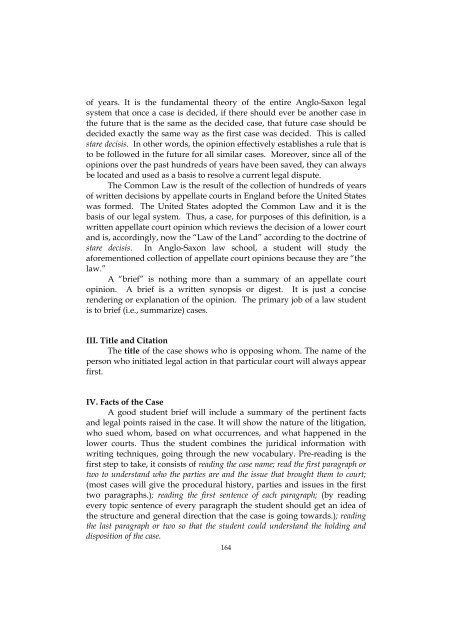translation studies. retrospective and prospective views
translation studies. retrospective and prospective views
translation studies. retrospective and prospective views
You also want an ePaper? Increase the reach of your titles
YUMPU automatically turns print PDFs into web optimized ePapers that Google loves.
of years. It is the fundamental theory of the entire Anglo-Saxon legal<br />
system that once a case is decided, if there should ever be another case in<br />
the future that is the same as the decided case, that future case should be<br />
decided exactly the same way as the first case was decided. This is called<br />
stare decisis. In other words, the opinion effectively establishes a rule that is<br />
to be followed in the future for all similar cases. Moreover, since all of the<br />
opinions over the past hundreds of years have been saved, they can always<br />
be located <strong>and</strong> used as a basis to resolve a current legal dispute.<br />
The Common Law is the result of the collection of hundreds of years<br />
of written decisions by appellate courts in Engl<strong>and</strong> before the United States<br />
was formed. The United States adopted the Common Law <strong>and</strong> it is the<br />
basis of our legal system. Thus, a case, for purposes of this definition, is a<br />
written appellate court opinion which re<strong>views</strong> the decision of a lower court<br />
<strong>and</strong> is, accordingly, now the “Law of the L<strong>and</strong>” according to the doctrine of<br />
stare decisis. In Anglo-Saxon law school, a student will study the<br />
aforementioned collection of appellate court opinions because they are “the<br />
law.”<br />
A “brief” is nothing more than a summary of an appellate court<br />
opinion. A brief is a written synopsis or digest. It is just a concise<br />
rendering or explanation of the opinion. The primary job of a law student<br />
is to brief (i.e., summarize) cases.<br />
III. Title <strong>and</strong> Citation<br />
The title of the case shows who is opposing whom. The name of the<br />
person who initiated legal action in that particular court will always appear<br />
first.<br />
IV. Facts of the Case<br />
A good student brief will include a summary of the pertinent facts<br />
<strong>and</strong> legal points raised in the case. It will show the nature of the litigation,<br />
who sued whom, based on what occurrences, <strong>and</strong> what happened in the<br />
lower courts. Thus the student combines the juridical information with<br />
writing techniques, going through the new vocabulary. Pre-reading is the<br />
first step to take, it consists of reading the case name; read the first paragraph or<br />
two to underst<strong>and</strong> who the parties are <strong>and</strong> the issue that brought them to court;<br />
(most cases will give the procedural history, parties <strong>and</strong> issues in the first<br />
two paragraphs.); reading the first sentence of each paragraph; (by reading<br />
every topic sentence of every paragraph the student should get an idea of<br />
the structure <strong>and</strong> general direction that the case is going towards.); reading<br />
the last paragraph or two so that the student could underst<strong>and</strong> the holding <strong>and</strong><br />
disposition of the case.<br />
164












